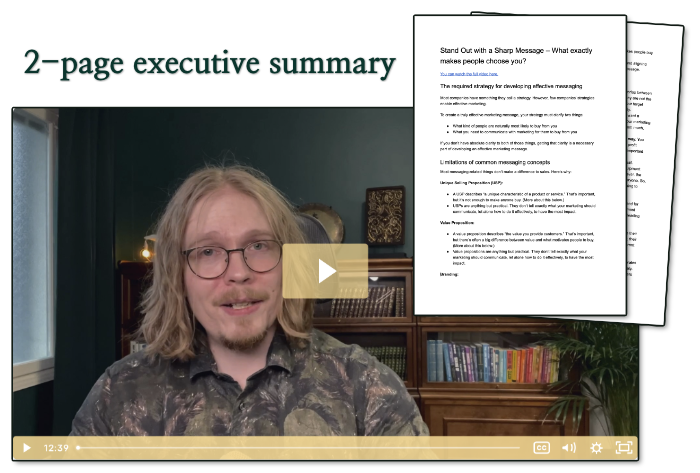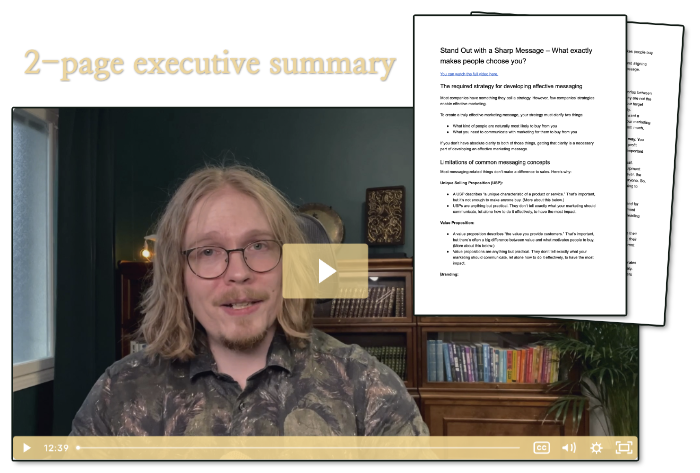Don’t look at normal email click-through rates. They make decision-making unnecessarily difficult.
You might think the usual click rates are fine since all the email marketing programs and nearly all marketing experts talk about them.
But there’s a much better way to analyze email opens, and it’s just as easy.
If you don’t understand the problem, you’ll look at the wrong numbers, likely interpret them wrong, and make the wrong decisions for your business.
What are the normal email click-through rates?
If you send an email to 1000 people and 25 of them click a link, email marketing programs tell you the click-through rate is 2.5%.
They didn’t count it wrong. They just counted the wrong thing.
The smarter option
The key is to consider the open rate first.
Let’s say you send an email to 1000 people and 250 of them open it. If 25 of them click a link, that means 10% of people who opened the email also clicked.
That’s the click-through rate you want to look at most of the time.
So, why count it based on opens, instead of recipients?
What do the numbers tell you?
Usually people see click-through rates as an overall “how good this email was” score.
That’s not entirely wrong, but it’s not very useful.
First consider the open rate of an email. It tells whether people found the topic interesting or not and how good the subject line was. You get the clearest signal if your subject line describes the topic clearly (because opening the email clearly shows interest in the topic).
Also note that you should consider open rates in the context of your usual open rates. If most of your emails get 20% open rate, an email that gets 35% open rate must be great. For someone else, 35% open rate is terrible.
So, the open rate refers to how many people were interested in the topic of the email. And your click-through rate (compared to opens) is about how effective the email itself was at compelling people to take the next step.
How to interpret a high click-through rate
Here are some basic assumptions you can make based on high click-through rates and common causes of low click-through rates (compared to opens):
High click-through rate:
- The people who opened the email want to learn more about the topic than what’s included in the email.
- You presented the link in a way that made it seem like a natural next step to take.
Low click-through rate:
- The email didn’t keep people interested for long enough to reach the link.
- People misunderstood the topic of the email based on the subject line (i.e., they wanted to read about what they thought the email was about, not what it actually was about).
- The link doesn’t seem like a natural next step after reading the email.
- What you wrote to convince people to click the link wasn’t compelling.
- They got what they wanted from the email directly, so they didn’t have a reason to click.
What are high and low click-through rates?
Unfortunately, what is a “good” click-through rate depends on the context. Here are a few things that affect what click-through rates you should expect:
- How recently people have joined your list
- How aggressively you’ve cleaned your list (i.e., if someone doesn’t react to your emails for a while, how soon do you stop emailing them)
- What the open rate is (e.g., if very few people open an email, it can be an indication of the subject line being boring, which means the few who opened the email are more likely to be truly interested in the topic)
- How long the email is
- What the link leads to
- How clearly you tell what’s behind the link
- And so on…
But generally speaking, a good click-through rate (counted compared to opens) is 3-7% for the usual broadcast email for your general marketing email list. For more selective lists (e.g., customers, recent new subscribers, people who specifically joined a launch promo list), you’d hope for higher numbers.
However, even much lower numbers are sometimes fine. For example, my Friday scribbles emails often have an article (similar to this, but shorter) that ends with a single sentence or short paragraph mentioning the option of getting help. Here’s what it could look like:
“If you want to get better results with email marketing (or marketing generally), maybe I can help. Just reply to this email and tell me what you’re struggling with. Or you can read this page to learn a bit more about what I do.”
1% click-through rate in that context is high because most people who are interested in the article are not actively interested in hiring me.
Another warning about how email marketing programs count click-through rates
Email marketing programs reports click-through rates as a single number.
If you have many different links in an email, you need to dig deeper into the data to see which links people click. But in most cases, you should avoid having multiple different links in an email. Rather focus your efforts to “selling” a single next step.
If you’re on my list and get the weekly Friday scribbles emails, you know I break that rule almost every time. The “tidbits” at the end of each email often have links.
But those emails aren’t normal marketing emails.
The goal is to share something practical (the first part of the email). Hopefully, when you really want to grow your business, you’ve seen that I can make it easy to understand and practical, so you at least want to have a conversation with me.
So, the emails don’t primarily aim for an immediate step toward buying like most normal marketing emails do.
The tidbits are included because they’re fun. I have fun with them, and I get replies from people who enjoyed them all the time.
Also, even if the main topic isn’t relevant for you one week, the tidbits might still give you a great laugh, spark an interesting thought, or something else.
If you don’t already get the Friday scribbles emails, click here now.


